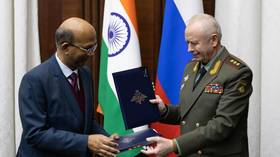Radar data debunks official MH17 findings, locator could not ‘miss’ missile – Russian air regulator

Russian radar could not have failed to notice a projectile approaching Flight MH17, despite the claims by a Dutch minister, the head of Rosaviatsia says. The lack of radar marks shows nothing approached the plane from the east, despite official findings.
Last week, the Dutch government published a series of replies by Security and Justice Minister Stef Blok, who explained to a parliamentary commission why radar data provided by Russia did not show any objects approaching the MH17 flight, including a Buk missile.
The radar, according to Blok, could simply miss a missile. The minister compared the radar to a lighthouse, claiming that a missile could slip through during its “turn” and therefore leave no trace on Russia’s Utes-T air route radar system. Blok also claimed that the radar could not register such a relatively small object as a Buk missile.
“It is inappropriate to say that a radar station could miss the missile,” the head of Russian aviation regulator Rosaviatsia, Oleg Storchevoy, said Tuesday, commenting on the latest Dutch claims.
The Russian Utes-T air route radar system is able to detect far smaller objects than a Buk missile, according to Storchevoy, and while its turn time is 10 seconds, Utes-T could not miss any object approaching the plane.
“If a projectile was moving along the trajectory described in the version of ‘launch on a head-on course,’ as the Dutch party claims, its flight time would be about 35 seconds. Accordingly, the radar would register at least two or three clear ticks – the so-called echo-signals from an object, moving towards the plane,” the official added.
While the MH17 black box data indicate that the tragedy took place at 13:20:03 GMT, Utes-T last registered the aircraft at 13:20:01.87, less than in a second and a half before the disaster, the Russian official added.
“There were no ticks [on the radar] near the MH17 trajectory, neither 1.5 seconds before the catastrophe, nor earlier – during three-to-four [radar] turns nothing was registered,” Storchevoy said. “This allows us to state that nothing approached the plane from the east side ahead of the disaster, as the official investigation is trying hard to present it.”
Last fall, a Russian radar producer reportedly discovered radar equipment that had been replaced during a scheduled maintenance shortly after the MH17 tragedy, and still held raw data from the day of the crash and handed it over to the Dutch investigation team.
The investigators appeared to be initially reluctant to decode it, citing its “unusual” format, while Russia has offered its assistance in decoding the radar data. At that time, Storchevoy suggested that such “stalling indicates the Dutch side’s wish to mislead the public.”
In September 2016, the Joint Investigation Team (JIT) of aviation experts and investigators from the Netherlands, Belgium, Australia, Malaysia and Ukraine stated that Flight MH17 was shot down by a Buk anti-aircraft missile, which was allegedly launched from a rebel-controlled village and approached the plane from the east.
The report also alleged that the Buk missile launching system, which allegedly shot down the MH17, was delivered from Russia and was returned back to Russia after the tragedy. Moscow has repeatedly disputed the findings, criticizing the investigation for its careless approach to MH17 debris, a significant part of which was left behind in eastern Ukraine, a lack of basic evidence, such as air control logs, and general political bias toward Ukraine.
Malaysia Airlines Flight MH17, with 298 people on board, crashed over eastern Ukraine in July 2014, amid an armed confrontation between the Ukrainian military and paramilitary forces, and rebels who rejected the armed coup in Kiev earlier that year. Western media immediately pinned the blame for the tragedy on the rebels and, ultimately, on Russia.















